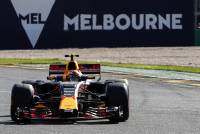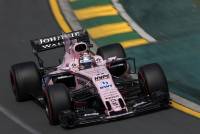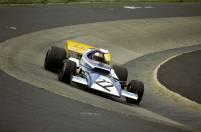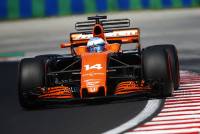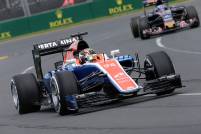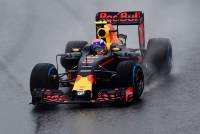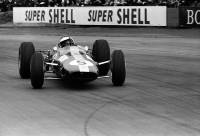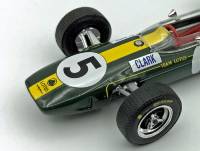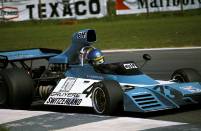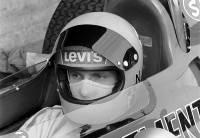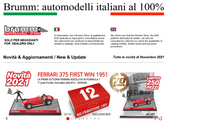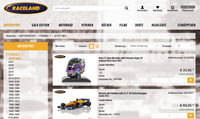New Items 2017
Red Bull Racing TAG Heuer RB13 Australian GP 2017 1:43 by Minichamps
It was a year of highs and lows for Red Bull Racing. With 13 DNFs the team from Milton Keynes was last in the reliability ranking. Expect the surprising victory of Daniel Ricciardo in Baku it took Red Bull until the Grand Prix of Hungary to be competitive. Two more victories were added by Max Verstappen in Malaysia and Mexico. At the end of the season Red Bull was third in the constructeurs championship clearly ahead of Force India but also far away from runner-up Ferrari. For next season Red Bull has a distinct target: The former worldchampion wants to beat the top-runners regularly. That can only happen if Red Bull and its engine supplier Renault get over the reliability. My opinion: «The first Red Bull RB13 made by Minichamps in 1:43 goes back to the first Grand Prix of 2017 in Australia. There the car had a black fin at the engine cover which is typical for the first races. Only from the Spanish Grand Prix on the RB13 looked much nicer with the numbers of the drivers at the back of the car. Concerning the details of the car Minichamps did (as usual) a fantastic job. The painting is absolutely perfect. Which is not self-evident. The matt blue is not easy to imitate. I am already looking forward to the model in 1:18. And as predicted to one with a more colourfoul fin on the top of the car.» f1modelcars rating: ✰✰✰
Für Red Bull war 2017 ein Jahr mit Hochs und Tiefs. Mit 13 Ausfällen belegte das Team aus Milton Keynes den letzten Platz in der Zuverlässigkeitswertung. Abgesehen vom überraschenden Sieg in Baku durch Daniel Ricciardo dauerte es bis zum Rennen in Ungarn, ehe Red Bull wirklich konkurrenzfähig war. In malaysia und Mexiko feierten die Bullen dann mit Max Verstappen zwei weitere Siege. Am Ende belegte Red Bull den dritten Platz in der Konstrukteurswertung. Klar vor Force India, aber auch deutlich hinter dem Zweitplatzierten Ferrari. Für 2018 ist das Ziel bei Red Bull Racing bereits definiert: Man will die beiden Top-Teams regelmässig schlagen. Das gelingt aber nur, wenn Team und Motorenpartner Renault die Zuverlässigkeit in den Griff bekommen. Meine Meinung: «Der erste Red Bull RB13, den Minichmaps in 1:43 auf den Markt gebracht hat, stammt vom Auftaktrennen, dem Großen Preis von Australien. Dort fuhr das Team noch mit einer schwarzen Finne auf der Motorabdeckung. Erst ab dem Grand Prix von Spanien wurde das Design mit den Startnummern der Fahrer angepasst. Wodurch die Finne deutlich besser ins Gesamtkonzept passt. In sachen Details hat Minichamps (wie üblich) tadellose Arbeit abgeliefert. Die lackierung ist perfekt. Was ich nicht als selbstverständlich erachte. Denn das matte Blau ist nicht so einfach zu imitieren, wie es scheint. Ich freue mich jetzt schon auf das 1:18er-Modell. Und auf eines mit einer farbigeren Finne als Motorabdeckung.» f1modelcars Note: ✰✰✰
Toro-Rosso-Renault STR12 GP China 2017 1:43 by Minichamps
The look of Toro Rosso was more or less unchanged the last few years. For 2017 the team from Faenza decided to have a complete new delivery – with a much lighter blue, some red stripes and silver logo and lettering. Altogether it reminds me of the original Red Bull can. If this was intended or not – I don't know. But for sure it is a fresh look. And I like it. From a sporting point of view Toro Rosso had a tough season. The STR12 was not a bad car but the Italians had some massive problems with the Renault power unit. Especially to the end of the season when it was clear that Toro Rosso will switch to Honda next year. The best of the four drivers Toro Rosso in 2017 was Carlos Sainz jr. Before he was transfered to Renault he was ninth in the championship with 48 points. The model I present you here shows #26, Daniil Kvyat. My opinion: «I was very curious how the new Toro Rosso of Minichamps looks like. Especially the colours. Because in reality the STR12 looks even more elegant than what we are used to on TV. But there is nothing one can complain about. The painting is like it should be. And the parts which are made of carbon look lso real. For any other competitior it will be difficult to have the same accurate suspensions like Minichamps has. Holding the model in my hands there is only one thing I don't like. According to my taste the nose of the Toro Rosso is much to thin compared to the rest of the car. But this has nothing to do how the model was built. It is the way Formula One looks like with its current regulations.» f1modelcars rating: ✰✰✰
Toro Rosso war die letzten Jahre von der Lackierung her immer ähnlich unterwegs. 2017 überraschte das Team aus Faenza die Fans mit einem komplett neuen Anstrich – mit einem helleren Blau, roten Streifen und Logo und Schriftzug in silber. Alles in allem erinnert mich der neue Auftritt von den farben her an das klassische Design der uns allen bekannten Red-Bull-Dose. Ob dahinter Absicht steckt oder nicht, kann ich nicht sagen. Aber es ist auf jeden Fall ein erfrischend neuer Look, der mir gut gefällt. Aus sportlicher Sicht hatte Toro Rosso ein schweres Jahr. Der STR12 war kein schlechtes Auto, aber die Power Unit von Renault machte immer wieder Ärger. Vor allem gegen Ende der Saison, nachdem Toro Rosso bekanntgeben hatte, dass man 2018 mit Honda-Motoren an den Start geht. Der beste der vier Toro-Rosso-Piloten 2017 war Carlos Sainz jr. Bevor er zu renault transferiert wurde, lag er an neunter Stelle mit 48 WM-Punkten. Der von mir gezeigte Toro Rosso STR12 zeigt die Version von Daniil Kvyat mit der #26. Meine Meinung: «Ich war sehr gespannt, wie der Toro Rosso von Minichamps aussehen würde. Besonders punkto Farben. Weil die Lackierung in Original eleganter daherkommt als wir es von manchen TV-Bildern gewohnt sind. Aber es gibt da nichts zu beanstanden. Die Lackierung ist, wie sie sein sollte. Und die Teile, die im Original aus Kohlefaser gefertigt sind, sehen am Modell aus, als hätte Minichamps tatsächlich auch Kohelfaser verwendet.Wenn ich das Modell so in der Hand halte, dann gibt es eigentlich nur etwas, was mir negativ auffällt. Die Nase am Toro Rosso ist für meine Begriffe im Verhältnis zum Rest des Autos viel zu dünn geraten. Aber das hat nichts mit der Umsetzung zu tun. So ist eben das aktuelle Reglement.» f1modelcars Note: ✰✰✰
Tyrrell-Ford 011 GP Monaco 1982 1:43 by TSM
Blue, black, green and – the year before – white: The Tyrrell 011 was a real chameleon! Therefore the Chinese manufacturer True Scale Model (TSM) produced the car which was originally built by Maurice Philippe in three different versions. The one we are talking about here is from the Grand Prix of Monaco in 1982. With the sponsor logos of Candy an Ceramica Italia. The car was driven by Brian Henton and Michele Alboreto. The latter won his frist Grand Prix at Las Vegas at the end of the season. Which was quite a surprise. My opinion: «From a present-day perspective Formula One cars without frontwing look quite strange. But at the beginning of the Eighties these kind of Formula One cars were state of the art. I always liked them. They looked a bit boofy. Exactly like the modelcar from TSM. the bottom line is that there is not much to criticise about the Tyrrell 011 from TSM. In some areas the model could be a bit more precise – especially if you consider the prize of 80 Euro. For example the rearwing which have no indication of any holes on the outside of the endplates. TSM also renounce on a driver figure. As we know them from Spark and Minichamps. But a driver figure can be easily upgraded. Besides there are collectors which prefer to put their modelcars without driverfigures in their display cases. So this doesn't give a black mark on the overall image.» f1modelcars rating: ✰✰✰
Blau, schwarz, grün und im Jahr davor weiss: Der Tyrrell 011 war ein wahres Chamäleon. Der chinesische Modellautohersteller True Scale Model (TSM) hat den Wagen von Designer Maurice Philippe deshalb gleich in drei Versionen herausgebracht. Die hier gezeigte stammt vom Monaco-GP 1982 mit den Sponsoraufschriften von Candy und Ceramica Imola. Gefahren wurde das Auto von Brian Henton und Michele Alboreto. Letzterer gewann damit überraschend den Großen Preis von Las Vegas am Ende der Saison. Es war Alboretos erster GP-Sieg. Meine Meinung: «Aus heutiger Sicht erscheinen Formel-1-Autos ohne Frontflügel gewöhnungsbedürftig. Doch Anfang der Achtzigerjahre war diese Art von Rennwagen an der Tagesordnung. Mir haben diese Autos immer sehr gut gefallen. Sie haben einen bulligen Eindruck hinterlassen. Und den hat TSM perfekt umgesetzt. Viel zu bemängeln gibt es jedenfalls bei dem Tyrrell 011 nicht. An einigen Orten dürfte man für diesen Preis (rund 80 Euro) noch etwas mehr Detailtreue erwarten. So zum Beispiel an den Endplatten des Heckflügels. Dort fehlen bei den TSM-Modellen die feinen Erhebungen der verschiedenen Einstellstufen. Auf eine Fahrerfigur, wie man sie von Spark und Minichamps kennt, verzichtet TSM. Die kann aber nachgerüstet werden. Ausserdem gibt es Sammler, die ihre Modelle lieber ohne Fahrer in die Vitrine stellen. Also kein Minuspunkt im Gesamtbild eines sehr gelungenen Modells des Tyrrell 011.» f1modelcars Note: ✰✰✰
Force India Mercedes VJM10 GP Australia 2017 1:43 by Minichamps
Pink is clearly not my favourite colour. Especially when we talk about racing cars. But I have to admit that the new delivery of Force India and partner BWT is not that ugly as I expected before the season. What I dislike more is the various other stickers all around the car which does not look very nice. It is a bit a smorgasbord. Apart from the discussion about the colour Force India proved once again in 2017 that this team works very efficently. Like last year the team from Silverstone is fourth in the constructeurs championship. This time clearly in front of Williams. With a smaller budget than most of the other teams! My opinion: «With the VJM10 Minichamps once again showed their skills in producing Formula One modelcars. There is no doubt that the car of Sergio Pérez and Esteban Ocon is identical with the model the German manufacturer produced. Also concerning the colour. What I really like at the VJM10 in 1:43 are the small waterdrops around the BWT-logo. Also the bargeboards which are getting more and more rich in detail are nicely made. So from my point of view: If you are not annoyed by the pink livery than this car must be added to your collection.» f1modelcars rating: ✰✰✰
Rosa is ganz klar nicht meine Lieblingsfarbe. Insbesondere wenn wir über Rennautos sprechen. Aber ich muss auch zugeben, dass die neue Lackierung von Force India und Hauptsponsor BWT nicht so hässlich ausschaut, wie ich es vor Beginn der Saison erwartet habe. Was mich am Force India mehr stört, sind die zahlreichen anderen Sponsorensticker, die etwas wahllos auf dem Rest des Autos verteilt wurden. Es erweckt den Eindruck eines Sammelsuriums. Sieht man einmal von der Farbe ab, hat Force India 2017 erneut bewiesen, wie effizient das Team arbeitet. Wie im Vorjahr ist man Vierter in der Konstrukteurswertung. Diesmal dklar vor Willimas. Und das mit einem Budget, das deutlich unter dem der meisten anderen Team liegt. Meine Meinung: «Minichamps hat mit dem VJM10 erneut unter Beweis gestellt, über welche Fähigkeiten der Modellbauer aus Aachen verfügt. Es gibt keinen Zweifel: das Original von Sergio Pérez und Esteban Ocon ist mit der 1:43-Verkleinerung von Minichamps absolut identisch. Auch was die Farbe betrifft. Was ich am Force India von Minichamps besonders gelungen finde, sind die Wasserdropfen rund um das BWT-Logo. Auch die Bargeboards, die immer detailreicher werden, sind sehr gut gelungen. Alles in allem: Wenn einen die Farbe pink nicht stört, dann gehört dieses Modell ganz klar in jede gut sortierte Sammlung.» f1modelcars Note: ✰✰✰
McLaren-Ford M23 Winner GP Brazil 1974 1:43 by Spark
The M23 was designed by Gordon Coppuck. And the car already won three races in 1973. With former worldchampion Emerson Fittipaldi at the wheel the first McLaren in Marlboro-colours was one of the top-runners in 1974. The biggest competitor of Fittipladi was Ferrari driver Clay Regazzoni from Switzerland. Both were equal on points when it all came together at the final race in Watkins Glen. But for both the weekend which was overshadowed by the fatal accident of Austrian driver Helmut Koinigg did not work well. Especially Regazzoni had big troubles. And he ended up the race on eleventh position with handling problems. Fittipaldi indeed got fourth. What secured him his second title and the first for McLaren. My opinion: «I always liked the McLaren M23 with its typical V-formation design. It was a simple but efficient racing car. Also the painting with the typical Marlboro-design was pioneering. Spark did an excellent job by converting the car into 1:43. Even the red colour is almost perfect. Which is not self-evident if you look at other manufacturer who released the M23 before. With the supplied decals the M23 looks (as it should be) like a real championship car.» f1modelcars rating: ✰✰✰
Der von Gordon Coppuck entworfene M23 hatte schon 1973 drei Rennsiege eigefahren. Mit dem 72er-Weltmeister Emerson Fittipaldi am Steuer wurde der erste McLaren im Marlboro-Design 1974 sofort zum WM-Anwärter. Größter Widersacher war dabei der Schweizer Clay Regazzoni auf Ferrari. Die beiden Kontrahenten kamen punktgleich zum WM-Finale in Watkins Glen. Und beiden lief das Wochenende, das vom tödlichen Unfall des Österreichers Helmut Koinigg überschattet wurde, nicht nach Mass. Vor allem Regazzoni kam nicht in die Gänge und verlor im Rennen mit Handlingsproblemen als Elfter schliesslich die WM an Fittipaldi, der Vierter wurde. Für McLaren gab es beim Finale gleich doppelten Grund zum Feiern. Neben dem ersten Fahrertitel sicherte sich das Team aus Woking 1974 auch zum ersten Mal die Konstrukteurskrone. Meine Meinung: «Der McLaren M23 hat mir meiner seiner Keilform schon immer gut gefallen: ein einfaches, aber höchst effizientes Auto. Der erste McLaren im Marlboro-Look war auch vom Design her bahnbrechend. Beides hat Spark bei dieser 1:43er-Miniatur perfekt hingekriegt. Auch das Rot, das von manch anderen Herstellern nicht immer perfekt getroffen wurde, ist dem Original sehr nahe. Mit Hilfe der beigelegten Werbedacals ist der M23 – wie es für ihn gehört – ein weltmeisterlich ausschauendes Modell.» f1modelcars Note: ✰✰✰
March Eifelland E21 German GP 1972 1:43 by Spark
The Eifelland E21 is one of the most bizarre Formula One cars of the history. It was built by Luigi Colani, a German designer who built everything – from toilet bowls to lorries. When Colani got the order from Formula Two teamprincipal Günther Hennereci to build a Formula One car the designer slightly overstated. Indeed the prototype looked spectacular but the car had some massive problems because it had no cooling. Colani had the rebuilt the car several times. What remained was the car Rolf Stommelen drove from the Grand Prix of Spain onwards. Some of the ideas survived anyway. Such as the monstrous mirror in front of the driver as well as the cockpit which looked like a bathtub. My opinion: «Spark has released different versions of the Eifelland-March. Apart from the white version which was used in South Africa there are also two blue versions. One from Spain, the other one from the Nürburgring. Both are absolutely accurate models. And they clearly show how miserable the visibility was for driver Rolf Stommelen due to this massive mirror. The coulours Spark chose are absolutely brillant. Whereas I prefer the version with the yellow rear wing from the German GP because it gives the car a better contrast.» f1modelcars rating: ✰✰✰
Der Eifelland E21 ist eines der skurrilsten Autos der Formel-1-Geschichte. Entworfen hat es Luigi Colani, ein deutscher Designer, der von der Kloschüssel bis zur LKW-Zugmaschine so ziemlich allem eine neue Form gegeben hat. Als Colani von F2-Teamchef Günther Hennerici den Auftrag bekam, dem March 711 ein neues Design zu verpassen, ging Colani allerdings ein paar Schritte zu weit. Der Prototyp des Eifelland-March sah zwar spektakulär aus, hatte aber massive Probleme, weil Colani keine Kühlung für das Auto vorgesehen hatte. So musste der Designer zurückrudern. Übrig blieb die Version, die Rolf Stommelen ab dem GP in Spanien fuhr. Wobei einige Merkmale, wie der mittig verwendete Rückspiegel oder das Cockpit, das einer Badewanne gleicht, «überlebten». Meine Meinung: «Spark hat sich dem Eifelland-March in verschiedenen Versionen angenommen. Neben der in Südafrika eingesetzten weissen Version, die in Südafrika zum Einsatz kam, gibt es die blaue Variante von den Rennen in Spanien und am Nürburgring. Beides sind absolute Top-Modelle, die auch verdeutlichen, wie schlecht damals die Sicht aufgrund des Rückspiegels für Rolf Stommelen gewesen sein muss. Farblich hat Spark den Eifelland perfekt getroffen. Wobei ich die Variante mit dem gelben Heckspoiler (GP Deutschland) der blauen Version vom GP Spanien vorziehe. Es gibt dem Auto einfach einen besseren Kontrast.» f1modelcars Note: ✰✰✰
McLaren-Honda MCL32 Chinese GP 2017 1:43 by Minichamps
McLaren on pole? Due to the lack of horsepower the second oldest team in F1 will not be on pole so quickly. At least in reality. Looking at the modelcar-scene it is different. There the MCL32 from Minichamps in 1:43 is the first model of the current season I can present. Previously you had to wait untill the new season to get the first models of the previous year. Nowaday – thanks to Resine and new, improved workflows – the fans can already enjoy the current generation in the middle of the year. For all the supporter of McLaren-Honda there is only one wish left: Hopefully the results will get better in the second half of the season. My opinion:«Minichamps has improved quality again. The level for itself and the competitors is now very high. The orange-black car of Fernando Alonso and Stoffel Vandoorne is an absolute eye-catcher from the frontwing to the T-wing which is unfortunately in vogue this season. The painting with the pearl effect is terrific. And the parts which imitate carbon fiber look like real. The best thing would be: sit in the car and drive it.» f1modelcars rating: ✰✰✰
McLaren auf der Pole? Was aufgrund des PS-Defizites von Motorenpartner Honda nach wie vor undenkbar ist, gelingt dem zweitältesten Team der Formel 1 immerhin im Modellauto-Sektor. Der MCL32 von Minichamps in 1:43 ist das erste Modell der laufenden Saison. Früher hat man jeweils bis zur neuen Saison warten müssen, ehe die ersten Vorjahresmodelle erschienen sind. Heute – dank Resine und neuen, verbesserten Arbeitsabläufen – kommt der Fan schon Mitten im Jahr in den Genuss der aktuellen Fahrzeuggeneration. Bleibt dem McLaren-Honda-Fan eigentlich nur noch etwas übrig: Hoffentlich werden die Ergebnisse in der zweiten Saisonhälfte noch besser. Meine Meinung:«Minichamps hat mit dem McLaren-Honda die Latte für sich und die Konkurrenz sehr hoch gelegt. Der orange-schwarze Renner von Fernando Alonso (Bild) und Stoffel Vandoorne ist von den vorderen Frontflügelleitblechen bis zum leider in dieser Saison dazugehörigen T-Flügel eine absolute Augenweide. Die Lackierung mit dem Perleffekt ist grandios. Und die Teilchen aus Kohlefaser sehen aus wie echt. Am liebsten würde man in diesem Modell Platz nehmen und losfahren.» f1modelcars Note: ✰✰✰
Manor-Mercedes MRT05 Australian GP 2016 1:43 by Spark
It was almost a miracle that Manor was ready for the start of the season 2016 in Australia. Although the team had built a new car over the winter there was a shortage of management personnel and, as always, a lack of financial resources. Nevertheless the notorious backbencher managed on February 22nd 2016 to introduce the new MRT05 car in Barcelona. Technically Manor was well positioned by the cooperation with Mercedes. Gearbox and rear axle were bought at Williams. The rest was «state of art». Manor renounced costly experiments. Instead the team who was formed around the former Ferrari technicians Nicolas Tombazis and Pat Fry focused on reasonable upgrades. Which allowed Manor to close the gap to the teams in front of them. My opinion:«Without sponsoring the last F1-Manor looks really naked. Even though I would like the new combination of the colours it is not my favourite Formula One car. Nevertheless Spark did once more an excellent job. The manor MRT5 in 1:43 is very much as it should be with tiny antennas and a very accurate frontwing. There is only one little thing: The red of the modelcar in 1:43 is a bit to bright compared to the real colour.» f1modelcars rating: ✰✰✰
Es grenzte an ein Wunder, dass Manor Anfang 2016 zum Start der Saison in Australien bereit war. Das Team hatte es über den Winter geschafft, ein neues Auto zu bauen. Und das, obschon die Führungsetage verabschiedet wurde und es wie in den Jahren zuvor finanziell düster aussah. Vorgestellt wurde der MRT05 am 22. Februar bei den Barcelona-Tests. Technisch war man dank der Kooperation mit Mercedes auf dem Motroensektor sehr gut aufgestellt. Getriebe und Hinterachse hatte man bei Williams eingekauft. Der Rest war «state of art». Manor verzichtete auf kostspielige Experimente. Stattdessen setzte das Team rund um die ehemaligen Ferrari-Techniker Nicolas Tombazis und Pat Fry auf vernünftige Entwicklungsschritte. Diese verhalfen Manor im Laufe der Saison immer mehr Boden gut zu machen. Meine Meinung:«Der MRT05 war ein fast sponsorenloses Auto. Deshalb wirkt er ziemlich nackt. Was schade ist. Denn eigentlich mochte ich die neue Kombination der Farben. Dennoch: Spark hat beim letzten F1-Manor alle Register gezogen. Das 1:43er-Modell entspricht mit seinen feinen Antennen und dem detaillierten Frontflügel exakt dem Original. Ein kleiner Wehrmutstropfen gibt es dennoch: Das Rot ist beim Modell in 1:43 heller geraten als es in echt erschienen ist.» f1modelcars Note: ✰✰✰
Red Bull Racing TAG Heuer RB12 Brazilian GP 2016 1:18 by Minichamps
He is the youngest GP winner of all time. And in 2016 he caused a sensation not only with his victory at the GP of Spain in Barcelona. Superstar Max Verstappen was outstanding – especially at the rainy GP of Brazil in Interlagos. Afterwards he was compared with the unforgettable Ayrton Senna. Great honors, but Verstappens feet are firmly on the ground. He said, the comparisons are nice, but he is not Ayrton Senna, he is Max Verstappen. Even in the modelcar scene Verstappen sets standards that only Michael Schumacher once achieved. Models of «Mad Max», like these to 750 pieces limited 1:18 miniature from the Brazilan GP with Intermediates, go like hot cakes. Especially in his home country, the Netherlands, modelcars of Verstappen are very much in demand. So: Watch out for more. My opinion:«Proportions and details are perfect. The paintwork, this deep flat dark blue, could not be better. I would have given ten points for Verstappens ride in Brazil 2016. The same applies to this Minichamps modelcar. You can't do better.» f1modelcars rating: ✰✰✰
Er ist der jüngste GP-Sieger aller Zeiten. Und er hat 2016 nicht nur mit seinem Triumph beim GP von Spanien in Barcelona für Furore gesorgt. Supertalent Max Verstappen ist vor allem beim verregneten GP Brasilien in Interlagos wie von einem Stern gefahren. Hinterher wurde er mit dem unvergesslichen Ayrton Senna verglichen. Was den jungen Niederländer ehrt, aber keineswegs aus der Fassung bringt. Die Vergleiche seien schön, aber er sei nun mal kein Ayrton Senna, er sei eben Max Verstappen. Auch in der Modellautoszene setzt Verstappen Maßstäbe, wie sie einst nur Michael Schumacher erzielen konnte. Modelle von "Mad Max", wie diese auf 750 Stück limitierte 1:18-Miniatur vom GP Brasilien mit Intermediates, gehen weg wie warme Semmeln. Vor allem in seiner Heimat, der Niederlande, sind Verstappen-Modelle begehrt. Also: "Watch out for more!" Meine Meinung:«Proportionen und Details stimmen perfekt. Die Lackierung, das tiefmatte Dunkelblau, könnte nicht besser sein. Für Verstappens Vorstellung in Brasilien 2016 gab es zehn Punkte. Dasselbe gilt für dieses Minichamps-Modell. Besser kann man es nicht machen.» f1modelcars Note: ✰✰✰
Lotus-Ford 33 England GP 1965 1:43 by Brumm
54 points were the maximum in 1965. Only the six best results were included in the rating. And for a victory one got nine points. Jim Clark reached the maximum score after only seven races. And at one of them the Scotsman even was missing: He renounced the GP of Monaco to compete in the Indy 500 instead. And what a surprise! He also won this race. In 1965 Clark was the dominator. And in combination with the Lotus 33 designed by Colin Chapman he was almost unbeatable. Brumm is not the first manufacturer who dared to produce the famous green Lotus 33. Spark also had the 33 from 1965 in its program – even in 1:18. And not to forget: Schuco launched its successful 1:16-series with exactly this Lotus in the mid-1960s. My opinion:«Brumm is proud of producing its diecast-modelcars 100% in Italy. And the Lotus 33 in 1:43 is a proof that nowadays good quality is not only available in China. Brumm launched the car in six different versions – among others with or without resin driver figure. Which allows the collector to have a handsome choice. Anyway there are some critics: the windshield could be done a bit more accurate. And the exhaust manifold is complet silver which looks a bit strange. Overall a nice diecast-model made in Europe!» f1modelcars rating: ✰✰
54 Punkte waren 1965 das Maximum. Denn nur die sechs besten Ergebnisse gingen in die Wertung ein. Und für einen Sieg gab es neun Zähler. Jim Clark erreichte diese Maximalpunktzahl nach lediglich sieben Rennen. Und eines davon ließ der Schotte sogar noch aus: Auf den GP von Monaco verzichtete er, um stattdessen beim Indy 500 anzutreten. Und welch große Überraschung! Auch dieses Rennen gewann er. Clark war 1965 schlechthin der Überflieger. Und in Kombination mit dem von Colin Chapman konstruierten Lotus 33 nahezu unschlagbar. Der italienische Modellautohersteller Brumm ist nicht der erste, der sich der grünen Weltmeister-Zigarre widmet. Auch Spark hatte den 33er-Lotus von 1965 schon im Programm – sogar in 1:18. Und nicht zu vergessen: Schuco lancierte Mitte der Sechzigerjahre mit dem Lotus 33 seine erfolgreiche 1:16er-Serie. Meine Meinung: «Brumm ist stolz darauf, seine Diecast-Modelle zu 100% in Italien herzustellen. Und der Lotus 33 ist der Beweis, dass Qualität heutzutage nicht nur aus China kommt. Brumm hat das Modell in sechs Versionen auf den Markt gebracht. Darunter auch Modelle ohne Resin-Figur. So hat der Sammler eine nette Auswahl. Trotzdem gibt es auch ein paar Kritikpunkte: die Winschutzscheibe hätte man etwas feiner hinkriegen können. Und auch die Auspuffkrümmer sind farblich nicht ganz getroffen. Alles in allem aber ein gut gelungenes Diecast-Modell aus Europa!» f1modelcars Note: ✰✰
Ferrari SF16-H 2016 1:43 by Bburago
2016 was not an easy year for Ferrari. The team from Maranello was not able to compete with world champion Mercedes. And Red Bull was also in front of the Scuderia at the end of the year. The SF16-H, the third model in the hybrid era, didn’t score a win. Sebastian Vettel had seven podium finishes, Kimi Raikkönen was four times in the top three. Ferrari only came close to a victory at the GP of Spain in Barcelona when both Mercedes were out of the race. But Red Bull secured the win with a more elaborate tactic. Vettel was second, Räikkönen third. It should remain the best season result. Among the model builders the SF16-H is nevertheless very popular. BBR and Look Smart have reduced the Italian F1-car in 1:43 and 1:18. And Bburago also devoted himself to the «red goddess» in 1:43 (and 1:32/1:18). The model shown here is 1:43. My opinion: «Considering the prize (10 Euro) and the fact that this model is a toy (ages 3+) and not a collecting item one have to admit that the SF16-H from Bburago is a surprising accurate model. If you compare it with the first 1:43-Ferrari, the F10 from 2010, Bburago did a big step forward. Suspensions and mirrors are of course rude. And they will stay like this. But you shouldn't compare it with a 100 Euro expensive collecting item like the one from Look Smart.» f1modelcars rating: ✰✰
2016 war kein kein einfaches Jahr für Ferrari. Gegen Weltmeister Mercedes sah man kein Land. Und auch Red Bull lag am Ende des Jahres vor der Scuderia. Der SF16-H, das dritte Modell der Hybrid-Ära, blieb sieglos. Sebastian Vettel kam auf sieben Podestplatzierungen, Kimi Räikkönen stand vier Mal auf dem Treppchen. Die «rote Göttin» kam nur einmal in die Nähe eines Sieges: beim GP Spanien in Barcelona, als beide Mercedes ausfielen. Doch Red Bull sicherte sich mit einer durchdachteren Taktik den Sieg. Vettel wurde Zweiter, Räikkönen Dritter. Es sollte das beste Saisonergebnis bleiben. Unter den Modellbauern ist der SF16-H dennoch sehr beliebt. BBR und Look Smart haben den Italo-Renner in 1:43 und 1:18 verkleinert. Und auch Bburago hat sich dem roten Flitzer in 1:43 (und 1:32 und 1:18) gewidmet. Beim hier gezeigten Modell handelt es sich um das Modell in 1:43. Meine Meinung: «Betrachtet man den Preis (rund 10 Euro) und die Tatsache, dass es sich hier um ein Spielzeug und nicht ein Sammlermodell handelt, dann ist der SF16-H von Bburago in 1:43 eine sehr gelungene Verkleinerung. Vergleicht man sie mit dem ersten Bburago F1-Renner in 1:43, dem F10 von 2010, dann wurde eindeutig ein Schritt nach vorne gemacht. Klar sind Aufhängungen und Rückspiegel sehr rudimentär. Und daran wird sich auch bei den zukünftigen Modellen nicht viel ändern. Aber dieses Modell darf auch nicht mit einer 100-Euro teuren Miniatur von Look Smart verglichen werden.» f1modelcars Note: ✰✰
Brabham-Ford BT42 Belgium GP 1974 1:43 by Spark
An English manufacturer, an Italian team, a French driver and Swiss sponsors: the Brabham BT42 which qualified for the one and only time at the Belgian GP in Nivelles in 1974 could not have been more European. But the only GP participation of two-time Le Mans winner Gérard Larrousse preceded a sad story. Actually Scuderia Finotto who bought two such Brabhams should have take care of the entries. But teamfounder Martino Finotto, a well-respected touringcar-driver in Italy, lost the pleasure of the project early on. And offered the two cars to pay-drivers. One of them was Silvio Moser. The Swiss had a sponsor with the awning-company Bretscher which could have financed the entry in 1974. Moser was supposed to drive the Brabham BT42 for the first time at the European seasonopener in Jarama. But one week before the Grand Prix Moser was so badly injured in a 1000 km race in Monza that he would never wake up again from his coma. Instead of Moser, who died a month after his terrible accident, Larrousse was sitting in the cockpit. In addition to Bretscher, whose logos were still stuck on the car, more Swiss sponsors appeared on the private BT42. Larrousse had at that time an agreement with the Swiss cheese union. So they put big stickers on the car to promote cheese from the Emmental and Gruyère. My opinion: «Colour and finishing of this Spark-model are brilliant. What I really like are the delicate mirrors. And the frontwing with its middle construction as well as the very nice coolingslots right and left.» f1modelcars rating: ✰✰✰
Ein englisches Fabrikat, ein italienisches Team, ein französischer Fahrer und Schweizer Sponsoren: Der Brabham BT42, der 1974 beim belgischen Grand Prix in Nivelles an den Start ging, hätte europäischer nicht sein können. Doch der einzigen GP-Teilnahme des zweimaligen Le-Mans-Siegers Gérard Larrousse ging eine traurige Geschichte voraus. Eigentlich hätte die Scuderia Finotto, die zwei solcher Brabham gekauft hatte, die Einsätze koordinieren sollen. Doch Teamgründer Martino Finotto, in Italien ein angesehener Tourenwagen-Pilot, verlor schon früh die Lust an dem Projekt. Und bot die beiden Autos Bezahlfahrern an. Einer von ihnen war Silvio Moser. Der Schweizer hatte mit der Markisenfirma Bretscher einen Sponsor an der Hand, der die Einsätze 1974 hätte finanzieren können. Moser sollte beim vierten WM-Lauf auf europäischem Boden erstmals ins Geschehen eingreifen. Doch Moser verunglückte eine Woche vor dem GP beim 1000-km-Rennen in Monza so schwer, dass er nie mehr aus dem Koma aufwachen würde. Statt Moser, der einen Monat nach seinem schrecklichen Unfall verstarb, saß beim darauffolgenden GP Larrousse im Cockpit. Neben Bretscher, dessen Logos weiter auf dem Auto klebten, prangten noch mehr Schweizer Sponsoren auf dem Auto. Larrousse hatte zu diesem Zeitpunkt nämlich ein Abkommen mit der Schweizer Käseunion. Diese warb großzügig mit Käse aus dem Emmental und Gruyère auf dem weiss-hellblauen BT42. Meine Meinung: «Die Farbe dieses 1:43er-Spark-Modells ist gut getroffen. Auch die Bedruckung ist ausgezeichnet. Was ich besonders mag sind die filigranen Rückspiegel. Sowie der Frontspoiler mit dem mittigen Steg und den durchgebrochenen Kühlungsschlitzen rechts und links.» f1modelcars Note: ✰✰✰
Tyrrell-Ford 019 Japanese GP 1990 1:43 by Spark
March-Ford 711 Austrian GP 1971 1:43 by Spark
The March 711 has written F1-history. Not only because of its special design. It was also the car in which Niki Lauda drove his first Formula One race in 1971 at the so called Österreichring. Engineer Robin Heard was convinced that aerodynamics would be the key to success. That's why he focused on it and gave brilliant aerodynamicist Frank Costin as much as clearance as he could. Costin himself surprised the other competitors with a completely new construction: the real eyecatcher was the front wing which soon became famous as the «tea tray». The 711-2 driven by Lauda was the second chassis March produced this year. Peterson drove it until mid-season. In Austria Lauda took over the car. With little success. Lauda was only able to turn the Cosworth engine up to 9000 rpm. What wasn’t a precaution because of the debutant it was more because the engine was old. So it was no surprise that the engine broke shortly after. A replacement was on the way to Austria. But it arrived late. That meant that Lauda couldn’t drive anymore on Friday. Saturday morning, free practice was already on the way for an hour, Lauda was back on the track with his new engine. But it got worse. After practice it turned out that the engine actually belonged to the car of Mike Beuttler. So the mechanics had to change the engine again. This time Lauda got the practice-engine of Beuttler. In the race Lauda had to stop after 22 laps on P17. The steering didn’t fit. My opinion: «Sparks number 3379 has not only a very interesting real car as its ideal, it is just a brillant modelcar with a superb red finishing. What I like to point out are the little cylinder heads.» f1modelcars rating: ✰✰✰
Der March 711 hat F1-Geschichte geschrieben. Nicht nur aufgrund seines eigenwilligen Designs. Es war auch das Auto, mit dem Niki Lauda 1971 am Österreichring sein erstes Formel-1-Rennen bestritten hat. Ingenieur Robin Heard war überzeugt, dass die Aerodynamik einen großen Teil zum Erfolg beitragen würde. Deshalb legte er besonderen Wert darauf und ließ den brillanten Aerodynamiker Frank Costin freie Hand. Der überraschte die Konkurrenz mit einer bisher nie dagewesenen Konstruktion: Vor allem der aufgesetzte Frontspoiler, von den Gegner liebevoll Teetablar (englisch: tea tray) genannt, sorgte für Aufsehen. Der von Lauda gefahrene 711-2 war das zweite Chassis, den March in diesem Jahr vom Stapel ließ. Peterson fuhr ihn bis Saisonmitte. In Österreich übernahm Lauda den Wagen. Ohne wirklich erfolgreich zu sein. Doch das hatte seinen Grund. Lauda durfte den Cosworth-Motor nur bis 9000/min drehen. Was weniger als Vorsichtsmaßnahme gegenüber dem Debütanten als gegenüber dem betagten Triebwerk anzusehen war. Trotzdem ging der Motor frühzeitig ein. Und weil das Ersatzaggregat erst von England aus unterwegs war, musste Lauda am Freitag zuschauen. Auch Samstagmorgen lief das Training bereits eine Stunde, ehe der junge Wiener eingreifen konnte. Doch es kam noch schlimmer. Nach dem Training stellte sich heraus, dass der Motor eigentlich in das Auto von Mike Beuttler gehörte. Also wurde wieder umgebaut. Und Lauda bekam dessen alten Trainingsmotor. Im Rennen schied Lauda auf dem 17. Rang liegend in der 22. Runde aus. Die Lenkung passte nicht. Das Handling war katastrophal. Meine Meinung: «Sparks Nummer 3379 hat nicht nur ein sehr interessantes Auto zum Vorbild, es ist ganz einfach ein brillant gelungenes Modellauto mit einer perfekten roten Lackierung. Was mir besonders gefällt, sind die kleinen Zylinderköpfe.» f1modelcars Note: ✰✰✰
Red Bull RB7 Demonstration Run Kitzbühel 1:43 by Minichamps
Red Bull is always good for surprises. In January 2016 the team from Milton Keynes converted a Red Bull RB7 from 2011 so that he could ride up and down on the notorious «Streif» in Kitzbühel. At the wheel of the model equipped with snow chains: Max Verstappen – at that time still a Toro Rosso driver. The young Dutchman liked the special ride. «I have never run on snow - it was a real challenge. The fact that I had to put my car in chains was very special. But it was great fun and the enthusiasm of the fans was great.» Minichamps built the «Pisten-Bully» in 1:43 and 1:18. The one in 1:18 is limited to 1500 pieces. In 1:43 there are 1584 pieces. Both models were sold out quickly. My opinion: «A smart idea (by Red Bull) and a smooth conversion by Minichmaps – in 1:43 and 1:18. Particularly nice made are the snow chains which Max needed for the ride on the slippery surface. Also the special livery on the sidepods with the reference to the forthcoming Grand Prix in Austria on the Red Bull Ring is unique and fits perfectly into the overall picture of the model.» f1modelcars rating: ✰✰✰
Red Bull ist immer für Überraschungen gut. Im Januar 2016 hat das Team aus Milton Keynes einen Red Bull RB7 von 2011 so umgebaut, dass er auf der berühmt-berüchtigten «Streif» in Kitzbühel eine eigens dafür präparierte Piste befahren konnte. Am Steuer des mit Schneeketten versehenen Modells sass Max Verstappen – damals noch im Dienste von Toro Rosso. Dem jungen Niederländer gefiel die rasante Fahrt. «Ich bin noch nie auf Schnee gefahren – eine echte Herausforderung. Dass ich meinen Wagen in Ketten legen musste, war schon sehr speziell. Aber es hat Spaß gemacht und die Begeisterung der Fans war großartig.» Minichamps hat den «Pisten-Bully» in 1:43 und 1:18 verkleinert. Die Verkleinerung in 1:18 ist auf 1500 Stück limitiert. In 1:43 gibt es das Modell 1584 Mal. Beide Modelle waren werkseitig rasch ausverkauft. Meine Meinung: «Eine geniale Idee (von Red Bull) und eine gelungene Umsetzung von Minichamps - in 1:43 und 1:18. Besonders gelungen sind dabei die Schneeketten, die Max für den Ritt auf der rutschigen Unterlage benötigte. Auch die spezielle Lackierung auf den Seitenkästen mit dem Hinweis auf den bevorstehenden Grand Prix in Österreich auf dem Red-Bull-Ring ist einzigartig und passt perfekt in das Gesamtbild des Modells.» f1modelcars Note: ✰✰✰

